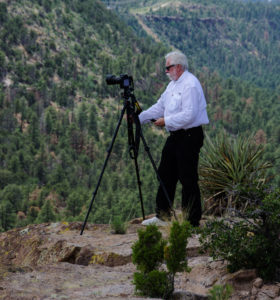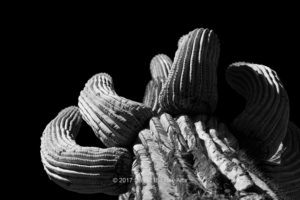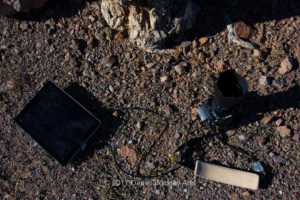Discovering the joys of photography on the down low
 Perspective is always important to photography, be it intellectual or physical.
Perspective is always important to photography, be it intellectual or physical.
An aesthetic viewpoint and a physical viewpoint are equally important.
For the most part photographers shoot from eye level. Sometimes they squat or kneel down for a shot, and often they climb up mountains and onto tall buildings to catch the view below.
 For most of my 45 years of desert dwelling life I have seen things almost exclusively from eye level.
For most of my 45 years of desert dwelling life I have seen things almost exclusively from eye level.
But over the past year or so I’ve become more interested in the desert at ground level. The crushed up rock and soil. The little rivulets that shape the terrain. Root structures, animal burrows and just the shadows spilling across the desert floor are fascinating. Even people’s shoes and feet.
To really see these things you have to get down low. At 63 years old and advanced in human bulk, this is easier said than done. The spirit is willing but the flesh is saying, “Yeah, but how are you getting back up again?”
Contents have settled during shipping.
 Some new tools are making the job a bit easier.
Some new tools are making the job a bit easier.
A company called Platypod (https://www.platypodpro.com) has created a plate with screws for adjustable legs and a mount to screw on a tripod head. Combined with the head, the Platypod Pro or Max can get your camera down to about five-six inches or so off the ground. Several manufacturers have also started making regular tripod with a flip-over mast that allows a stable platform for your camera even lower than that, although an inverted image results. Easiest fix in the world but a little disorienting.
Personally I’m interested in creating low perspective panoramas, so my requirements are a little different than those of single frame photographers. A tripod head with markings at the base to indicate in degrees the orientations of the shot make it easier to ensure that I have enough overlap in my consecutive shots to successfully create panoramas.
 A tripod leveler and a spirit bubble level for the hot shoe of the camera help make sure your shots are all level. And the more level the tripod is, the great the area your panoramic sequence will be able to connect.
A tripod leveler and a spirit bubble level for the hot shoe of the camera help make sure your shots are all level. And the more level the tripod is, the great the area your panoramic sequence will be able to connect.
A tripod makes every photo better. There is no substitute for a fixed platform for your camera. Every shot is crisper and more detailed. So having one that gets you down to that level takes a lot of the work out of shooting.
Even so, with the camera so low it’s hard to get down to the viewfinder, and even in monitor mode its tough to see that little screen without lying in the dirt (which was more fun in my teens and 20s than now).
 Manfrotto came up with a really great solution called Digital Director. It’s a frame that your iPad or iPad Pro plugs into. A USB port connects to your camera and sends the image that would normally going into the camera LED over to the ipad, where it can be viewed at larger size. Moreover the software gives you full control over where you set your focal point in the frame, as well as ISO, aperture and shutter speed. It’s downright phenomenal. When you take a shot, the image is ported to the iPad so you can see what you’ve got before you move the camera.
Manfrotto came up with a really great solution called Digital Director. It’s a frame that your iPad or iPad Pro plugs into. A USB port connects to your camera and sends the image that would normally going into the camera LED over to the ipad, where it can be viewed at larger size. Moreover the software gives you full control over where you set your focal point in the frame, as well as ISO, aperture and shutter speed. It’s downright phenomenal. When you take a shot, the image is ported to the iPad so you can see what you’ve got before you move the camera.
 Naturally the only big drawback for this kind of system is that the desert sunlight is so bright that it’s hard to see. A yard or two of black fabric from a fabric store makes a dark enough hood to solve that problem cheaply.
Naturally the only big drawback for this kind of system is that the desert sunlight is so bright that it’s hard to see. A yard or two of black fabric from a fabric store makes a dark enough hood to solve that problem cheaply.
I’m near the beginning of the learning curve as I delve into low perspective photography but I’m highly highly motivated to get up to speed before rattlesnake season starts. Not interested in photographing rattlers. I’m interested in avoiding them and their assorted poisonous desert pals by just giving them space when they’re most happy roaming around.
One of the things I’ve always wanted to do is photograph the nude as landscape. Reclining, crouching and in various contortions mimicking the terrain behind. The shapes, shadows and contours are essentially the same. It has been frustrating in the past to try this because of the limitations of tripods in terms of minimum height. I was always looking down on the subject. Now I feel I may be able to get some traction on that idea, and to layer those images with other landscapes to produce imaginary terrain.
Test work in that direction is already underway.

